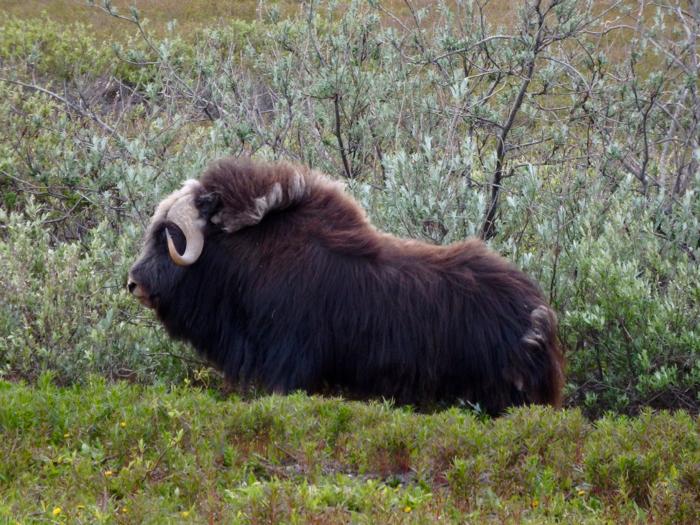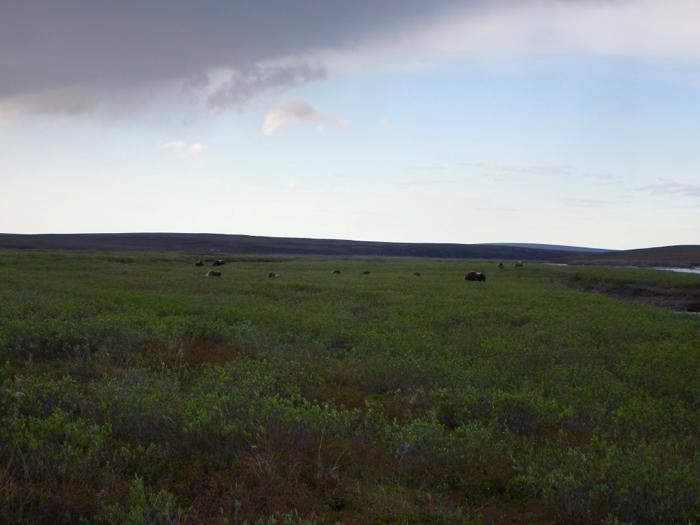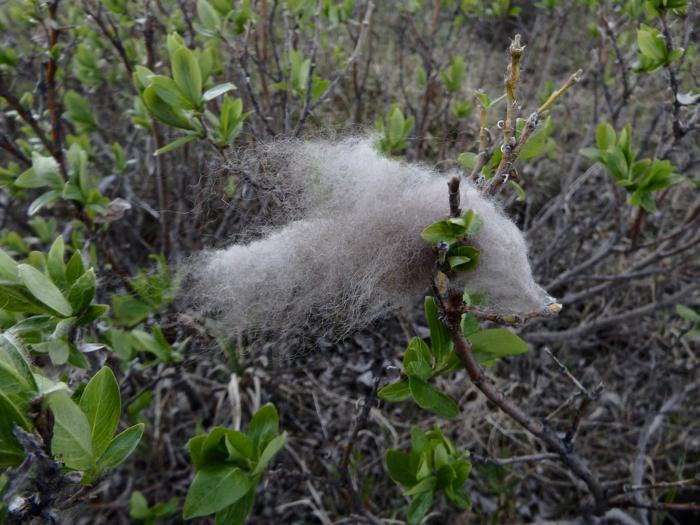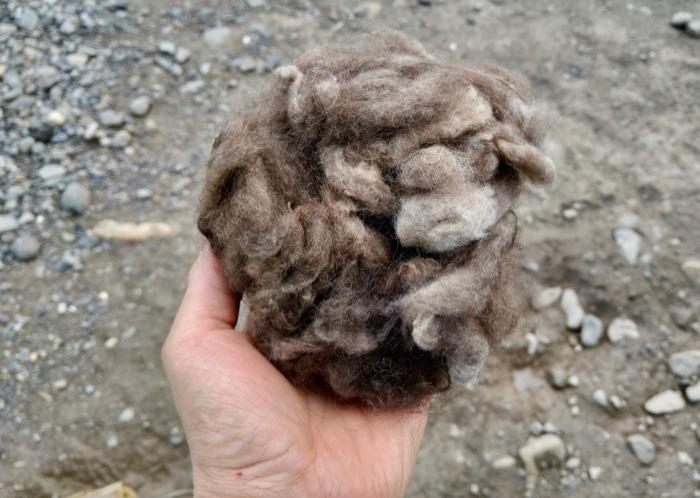Closer Look: Muskox
Pump 3, Dalton Highway, AK
June 7, 2019
Video of the Day:
Muskox (Ovibos moschatus) near Trans-Alaska Pipeline Pump 3. These animals rub against the shrubbery of the tundra during spring and summer months to shed their inner coat layer, called qiviut.
Earlier this week, Jason Dobkowski (lab manager and Toolik veteran) drove us up the Dalton Highway to Trans-Alaska Pipeline Pump 3 to view a herd of muskox that has been seen there. This was an amazing experience, and it prompted me to dive deeper to learn more about this animal.
 The global range of the muskox. You can see that populations in Alaska have all been reintroduced. Native populations on the North Slope were wiped out in the late 19th century, likely due to excessive hunting (Alaska Department of Fish and Game). Image Source: Kutz, et al., 2017.
The global range of the muskox. You can see that populations in Alaska have all been reintroduced. Native populations on the North Slope were wiped out in the late 19th century, likely due to excessive hunting (Alaska Department of Fish and Game). Image Source: Kutz, et al., 2017.
More closely related to sheep and goats than to the ox, the muskox is quite odd-looking. Its face resembles that of a cow, the exception being the large horn assembly, which suggests a large crop of hair parted down the middle. The body resembles that of a bison, with a thick coat of brown fur.
 Muskox (Ovibos moschatus) near Trans-Alaska Pipeline Pump 3. Dalton Highway, North Slope, AK.
Muskox (Ovibos moschatus) near Trans-Alaska Pipeline Pump 3. Dalton Highway, North Slope, AK.
 Muskox herd feeds near Trans-Alaska Pipeline Pump 3. Dalton Highway, North Slope, AK.
Muskox herd feeds near Trans-Alaska Pipeline Pump 3. Dalton Highway, North Slope, AK.
The name “muskox” references the animal’s distinctive odor, secreted by males during rut season. The smell likely comes from a class of compounds called γ-lactones (gamma lactones), secreted via urine and spread over the fur as the animal moves through the brush. The smell has been described as “light, sweetish, [and] ethereal.” 1
 Lactones are cyclic esters. An ester functional group consists of a carbonyl (C=O) with the carbon attached to at least one alkoxy (-O-R) group, where R is a hydrocarbon substituent. There are many different categories of lactones, and they are named according to the number of carbons in R (the number of carbons in the ring in addition to the carbonyl carbon). As seen above, α-lactone contains one carbon in R. γ-Lactone (boxed in red) contains three carbons in R.
Lactones are cyclic esters. An ester functional group consists of a carbonyl (C=O) with the carbon attached to at least one alkoxy (-O-R) group, where R is a hydrocarbon substituent. There are many different categories of lactones, and they are named according to the number of carbons in R (the number of carbons in the ring in addition to the carbonyl carbon). As seen above, α-lactone contains one carbon in R. γ-Lactone (boxed in red) contains three carbons in R.
I learned from Jason that the muskox has a bi-layered coat, and the inner layer (called qiviut) is shed in the spring and summer months. To aid the shedding process, these animals are often seen rubbing up against the brush of the tundra, almost as if they are itching themselves (see “Video of the Day” above).
Qiviut is both warmer and stronger than the wool of a sheep, and as a result, it is a prized material for making scarves, hats, and sweaters.2 It is very expensive - a brief online search yielded prices up to $70 per ounce!
 A piece of qiviut in the brush. You can follow these pieces of shed qiviut to mark the path of the muskox through the brush. Dalton Highway, North Slope, AK.
A piece of qiviut in the brush. You can follow these pieces of shed qiviut to mark the path of the muskox through the brush. Dalton Highway, North Slope, AK.
When viewing the muskox near Pump 3, we were able to follow their trail by noting the location of shed qiviut. Qiviut picking is a popular Sunday pastime amongst researchers at Toolik, and I collected a fairly large wad to bring back to my classroom.
 My haul of qiviut for the evening, collected near Pump 3 on the Dalton Highway, North Slope, AK.
My haul of qiviut for the evening, collected near Pump 3 on the Dalton Highway, North Slope, AK.
Comment below!


Comments
Add new comment